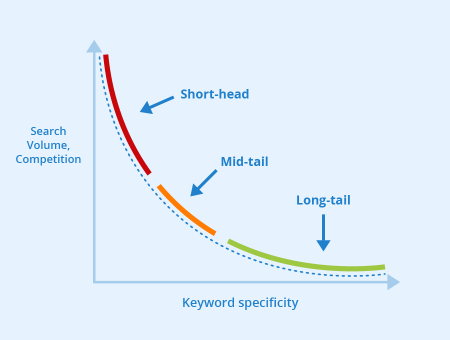Long Tail
Contents
Definition
The term long tail describes a theory developed by Malcolm Gladwell and promoted by Chris Anderson (US journalist and editor-in-chief of Wired magazine), according to which economic success on the internet can be achieved by offering niche products. When it comes to SEO, long-tail describes keywords and key phrases that are not as commonly used and serve a niche.
Long-tail keywords are short sentences or key phrases that usually have a lower search volume and are more specific than regular keywords. Despite being low-volume search terms, long-tail keywords are valuable for website owners and marketers due to their higher conversion rates when compared to standard keywords. Although they are not particularly popular in terms of search traffic volumes, their specificity makes them more likely to attract niche users.
Moreover, and as their name suggests, long-tail keywords are longer than typical search terms, which usually consist of one or two words. In most cases, a long-tail keyword will have anything from 3 to 6 words.
Long-tail keywords and how they work

Keywords are an important aspect of SEO. Optimizing your website for keywords that your target audience is likely to search for is essential in order to rank on search engine result pages. Most websites build their online marketing strategy around a central theme. But since not every page or piece of content can or should be optimized for the same keyword, it becomes necessary to diversify the keyword strategy.
One way to achieve this is by using a mix of short and long-tail keywords that target the audience at different stages of the customer journey. Short search queries tend to be generic and for informational purposes, whereas long-tail queries are usually performed by people who already know what they are looking for and are further along the conversion process. As an example, imagine you sell Caribbean cruises departing from Miami and want to draw attention to your site:
Optimizing your site for a short-tail query like “Caribbean cruises” would attract people with multiple search intents. For example, a user could be looking for general information about Caribbean cruises and doesn’t necessarily want to book a trip. That’s why conversion rates would typically be lower for such a broad and general search term.
On the other hand, the long-tail query “Caribbean cruises departing from Miami” would include people who have narrowed down their options and already have the intention to book that specific trip. This would likely lead to higher conversion rates.
How to find long-tail keywords
The first step is to make a list of possible keywords and phrases. To do this, you can:
Find topics related to your site’s main theme or product. For example, "DIY home renovation" is a long-tail key phrase, but instead of optimizing every page for the same keyword, it would be more effective to find related search terms that can also drive people to your site. Some examples would be “DIY home renovation on a budget”, “DIY home renovation for beginners”, “weekend DIY home renovation projects”.
Consider the goals or problems of your target audience. Using the example above, you may want to optimize for “DIY home renovation products”, but also for “How to get started with DIY home renovation” or “Essential tools for DIY home renovation”.
You can find long-tail key phrases within Google too, by typing in your keyword in the search box and noting the suggestions Google makes as you type with the autocomplete feature. Similarly, there are two sections within each search results page that can help find long-tail key phrases: “Searches related to” and “People also ask”.
Google can also help determine the extent of competition for a given long-tail keyword. Search result pages display the number of times a search term appears online, as well as the best ranking companies for that key phrase. If the first few search results are topped by large or renowned businesses, it may be worth considering ranking for alternative keywords.
Alternatively, you can use keyword research tools or plugins created for this specific purpose. These are usually built into SEO tools and can yield hundreds and sometimes thousands of long-tail search terms that can be incorporated into your SEO strategy. For example, Seobility provides a helpful free Keyword Research Tool.
Other ways to find long-tail keywords include:
- Google Trends, especially useful for seasonal content.
- Keyword research tools in social media, such as autocomplete Instagram hashtags, Twitter search, and YouTube’s keyword tool.
Advantages and disadvantages of long-tail keywords
Advantages
- Less competition, since there aren’t as many sites or companies optimizing their content for specific search terms.
- Long-tail keywords can help new or small websites rank relatively fast and be discoverable by their audience.
- They can generate higher conversion rates than a single keyword with a higher search volume.
- Long-tail keywords are usually assigned a lower price in paid SEO campaigns and PPC schemes like Google Ads.
Disadvantages
- They require attention to copy quality so that it is easily readable and the long keyphrases do not come across as spammy or unnaturally placed.
- Long-tail keywords may have a limited reach due to their specificity and to being niche-oriented. For optimal reach, an SEO strategy should include both short and long-tail keywords in order to deliver both high traffic volume and high conversion rates.
Related links
- Keyword Research And Analysis: How To Find The Best Keywords For Your Website - Seobility Blog
- https://www.searchenginejournal.com/seo-long-tail-keywords/204482/
Similar articles